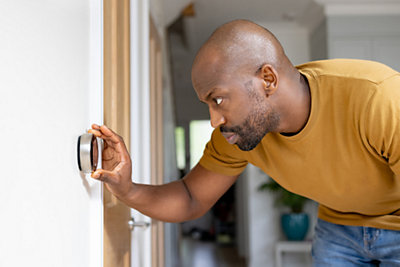Dialing In: The Ideal AC Temperature for Your Comfort and Savings
Do you ever find yourself setting the AC to a bone-chilling 60°F to beat the summer heat? Or perhaps you're guilty of turning your AC off completely to save on your electricity bill? Whatever your approach, we're here to tell you that there is an ideal AC temperature that can provide both comfort and savings.
And guess what? It's not as low as you might think. According to the Department of Energy, the best temperature to set an AC unit is 78°F when home during the day. However, we know that adjusting the thermostat can feel like a game of hot and cold, especially when trying to find that sweet spot during summer heat waves.
So, follow along as we break down everything you need to know about finding the ideal AC temperature for your home. In this article, you'll find the following:
Why is 78 the Best Temperature to Set an AC Unit?
What's the Best AC Temperature for Sleeping?
How to Regulate the Indoor Temperature
How to Save Money on Your Energy Bill
Keep scrolling to explore the full guide!
Why is 78 the Best Temperature to Set an AC Unit?
Cranking your AC to arctic temperatures might sound like a good solution, but it hurts both your wallet and the environment. But where does the magic number 78 come from and why is that the best temperature to set an AC unit?
According to the Department of Energy's advice, the easiest way to save up to 10% annually on heating and cooling is by turning your thermostat back 7° to 10°F from its normal setting, for at least eight hours each day.
However, that's not all they suggest - keeping indoor and outdoor temperatures close to each other can also reduce your overall cooling costs. During winter, it's best to keep your thermostat setting between 68°F to 70°F while awake and dial it down while sleeping or away from home.
You can follow the same principle in summer by keeping your place warmer than normal when you're away. But why is 78°F the sweet spot for summer days? That sounds awfully warm. It's simple - it's the temperature that balances both comfort and energy savings. Additionally, setting your thermostat at 78°F also means helping the environment by reducing CO2 emissions.
The good news? The percentage of savings is greater for those in milder climates! So, if you're blessed to live in areas with mild climates, brace yourself for some additional savings throughout the year by following these tips.
What's the Best AC Temperature for Sleeping?
So, should you be expected to sleep in 78°F heat year-round? Again, that sounds awfully hot for most people (particularly those in the country's southern half).
According to the Department of Energy, you only need to have your air conditioning set at 78°F for about eight hours daily. This means you can dial it down while you sleep, and medical experts actually suggest you do just that.
Medical News Today suggests the optimal sleeping temperature is around 65°F for quality sleep. When you set your thermostat at around 65°F, you can benefit from an improved core body temperature that impacts the sleep-wake cycle. Furthermore, sleeping with cool air can help prevent heat-related conditions, such as:
Dehydration
Heatstroke
Heat exhaustion
However, depending on where you live, you might be able to get enough cool air circulating in the room if you turn on ceiling fans (which should also lead to energy savings, too).
How to Regulate the Indoor Temperature
Now that you know that magic number is 78°F, you might be wondering how to set your thermostat properly to regulate your home's indoor temperature.
After all, it's exhausting to constantly adjust your air conditioner throughout the day to feel comfortable in your home. Lucky for you, there are various ways to regulate your indoor temperature and save money on your energy bill.
Invest in a Smart or Programmable Thermostat
Smart thermostats (also called programmable thermostats) allow you to set the temperature in your home based on your schedule. You can program it to decrease the temperature at work and increase it before you arrive home. This way, you're not wasting energy and money to heat or cool an empty home (plus, they look much cooler than old thermostats).
Seal Cracks and Gaps
You may not realize it, but cracks and gaps around windows and doors can let hot, humid air into your home. This can make your AC unit work harder to cool your home. Take a walk around your house and look for any openings. You can seal them with caulk or weatherstripping. This is a simple and cost-effective way to keep your home cool and save money.
Use Ceiling Fans
As mentioned, ceiling fans are a great way to circulate air throughout your home (especially while you sleep). This can make your home feel cooler without lowering the temperature on your thermostat. Plus, ceiling fans use less energy than your AC unit so you can save money on your energy bill.
Keep Your AC Unit Clean
A dirty AC unit is less efficient, causing it to work harder to cool your home. This can lead to higher energy bills and a shorter lifespan for your unit. Ensure you change your air filter regularly and clean the outdoor unit when necessary. This will help your AC unit run smoothly and keep your home cool.
Use Curtains and Blinds
The sun can quickly heat your home, especially during the summer months. To prevent this, use curtains or blinds to block out the sun's rays. Close them during the hottest parts of the day, from mid-afternoon until evening. This can make a big difference in regulating your indoor temperature.
How to Save Money on Your Energy Bill
Ahhh, the sweet, sweet relief of air conditioning on a hot summer day. But, as wonderful as it feels, it can also wreak havoc on your energy bill (yes, even if you have it set at the suggested optimal temperature). However, with a few easy tweaks, you can stay cool and save some serious coins.
Set Your Thermostat Fan to "Auto"
Let's start with an easy one. When your thermostat fan is set to "on," it runs constantly, which can be super energy-intensive. Consider switching it too "auto" instead. This way, the fan will only turn on when your AC is actively cooling your home. Minor changes like this can add up to substantial savings over time!
Get with the Program
Okay, we've already briefly touched on this above, but it's worth mentioning again. Investing in a programmable thermostat is like having a little energy-saving robot in your home working tirelessly for you to help you save energy (and, thereby, cash).
You can set your desired temperature for different times of the day, so your AC won't be working overtime when no one is home. Plus, you won't have to remember to adjust the temperature before leaving the house. Talk about convenience!
Ditch the Incandescent
Ugh, we know, you likely love those old-school incandescent lightbulbs. They give off a warm glow, and thanks to their inefficiency, they double as a home heater (kidding, kind of). But the truth is, LED bulbs are where it's at. Not only do they consume less energy, but they also last way longer. Win-win!
Filter, Filter, Filter
Again, this calls for a second mention, too. Your AC system works hard to pump cold air through your home. Don't handicap it by making it push air through dirty filters. A dirty filter forces the AC to work harder to get air through the system, which is bad news for your energy bill. Check your filter every month or two, and replace it as needed (or schedule an AC tune-up with us!).
Reduce Heat Sources
Heat sources like lighting, cooking appliances, and electronics can increase your home's temperature, causing your air conditioning system to work harder. Turning off unnecessary lights and appliances and keeping your electronic devices in standby mode can reduce the heat generated and decrease your energy usage.
Go Green
No, we're actually not talking about recycling - we're talking about planting trees! If you want to keep your home cool without relying too much on your AC, consider planting trees or installing shade devices outside your home.
Not only does this add to your home's curb appeal, but it also blocks the sun from directly hitting your home, so your AC won't have to work as hard.
Get an AC Maintenance Membership
When it comes down to it, finding the best temperature to set an AC unit at is essential for both your comfort and savings. That's why Parker & Sons is committed to helping homeowners stay cool and save money with our PFP plan.
With our 40-point heating and air conditioning tune-up, you can rest easy knowing that your equipment is running efficiently and preventing costly repairs. Plus, regular maintenance can save you up to $100 a month on your utility bills. And with our monthly and annual agreements, saving money has never been easier.
So why wait? Sign up today to stay cool and save big with us!
Related Reading
Subscribe to our e-Newsletter
Stay up-to-date on current news, promotions, and industry tips.

